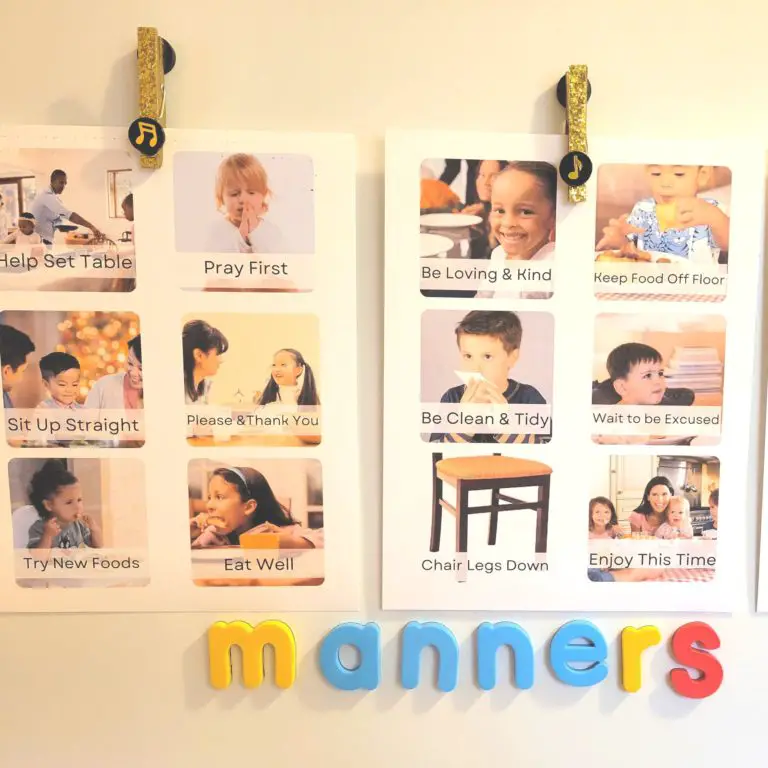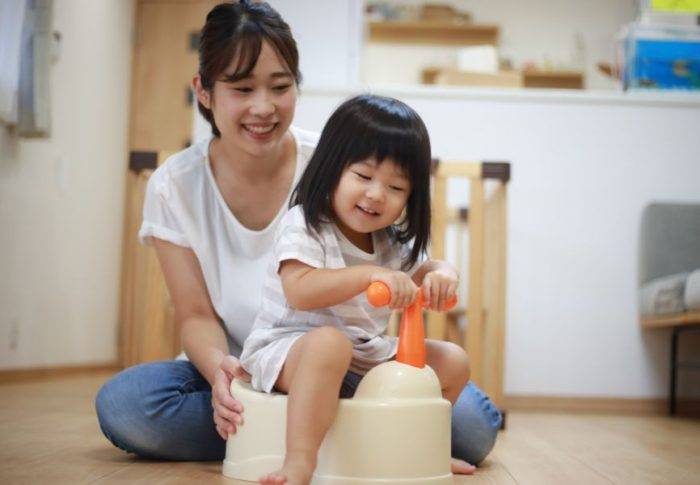
Less Toddler Mealtime Battles: 10 Easy Tips
Table of Contents
Toggle- Set Your Toddler Up For Mealtime Success, Not Battles
- 1. Build Excitement for Meals by Having them Help.
- 2. Avoid TV or Screen Time Right Before Meal
- 3. Tired Toddlers Lead to More Mealtime Battles Try to Eat Earlier
- 4. Have Your Toddler Help Say the Prayer
- 5. Table Manners for Toddlers
- 6. Talk to the Hand...Puppet How to Get Your Toddler to Eat
- 7. Power Struggles at the Table can Lead to a "Reset"
- 8. Include Your Toddler in Your Conversation As Much As Possible
- 9. If Your Toddler Throws Food Down, Try This Tip
- 10. Busy Box to the Rescue when Your Toddler is Done Eating
- Less Mealtime Battles With Your Toddler Means More Peace and Fun for your Family
Set Your Toddler Up For Mealtime Success, Not Battles
Mealtime -especially dinner time can be one of the most challenging times with toddlers. Many times they eat very little, have trouble sitting still or don’t want to stay at the table. Follow these simple tips to help minimize toddler mealtime battles and struggles. Planning and strategy are your best friends in this pursuit. Here are 10 ideas I hope will help you and your family.
1. Build Excitement for Meals by Having them Help.
A toddler’s attention span is often long enough to help with one aspect of meal preparation. Including them in your cooking process can make them feel like part of the team and they take pride in their work. Think of something they can do to help like: setting the table, picking up chopped veggies and placing them in a pot, stirring, picking out their bibs, etc. If you have a garden, they can help pick the veggies for dinner. My daughter loves to cut lettuce for our meal with her safety scissors from the dollar store.
If my daughters are curious about the food I am making and I have something they can eat-like salad vegetables that are ready to eat, I will give them a sample if they would like. It is hard to get them to eat sometimes, so if they are willing to try some bites, I am happy if they are eating something!
When they start to loose interest in helping, you can help them find another independent activity to do.
Make sure to let others know at the table what your child helped with so they can get positive feedback for their efforts.
2. Avoid TV or Screen Time Right Before Meal

Having our toddlers watch their favorite show while I am making dinner can be so helpful. They enjoy the program at a time when I’m not as available to be with them. I have found however, that there is a magic window of time that is best to turn off the tv before we eat.
I try to listen for the end of a program and turn it off at least 10-15 minutes before we eat rather than letting it continue to the next show. If I turn off the show a minute before it is time to come to the table, there is likely to be resentment and tantrums. This starts dinner off to a rocky start.
What I do now is find a moment that is a good stopping point for their show. When there is plenty of time before dinner and I explain that it will be time to eat soon and I tell my girls to say “Bye Bye” to Daniel Tiger (for example). Then I let one of them push the off button on the remote. This gives them more of a feeling of control rather than turning it off myself abruptly.
Next, I help them find another activity that will make a smoother transition to the table. This could be helping set the table, playing with blocks or making something in their play kitchen. This is also a great time for a potty break or diaper change.
3. Tired Toddlers Lead to More Mealtime Battles: Try to Eat Earlier

This is one of my biggest struggles. It seems like a 30 minute meal can take me over an hour to make now with distractions and diaper changes. I find if dinner is too late, I end up giving them a snack because I feel guilty that I don’t have dinner on the table yet. Then they are less likely to eat well at dinner. Toddlers can also become more cranky and less cooperative when they are too tired. Having dinner earlier might mean prepping earlier in the day, making simpler meals or starting cooking dinner earlier if possible. If you have dinner earlier and avoid snacking before hand, dinner can be much more enjoyable for all!
4. Have Your Toddler Help Say the Prayer

Having your toddler help say the prayer is a great way to include them in your family traditions. We like to use the “God is great, God is good” one. If they dig into their food when I set it down, it is hard to get them to stop and pray. We have found that if we want them to wait, we just don’t put their plate down until they pray and we are all ready to start. Eventually we can have their plate on the table when they pray when their impulse control is more developed.
5. Table Manners for Toddlers
Teaching table manners can be done at the table and even away from the table. Modeling these manners ourselves can be one effective way to teach them to our children. Saying please and thank you can be practiced in many situations.
Table manner flash cards are another fun way to teach manners. Visit my shop for a beautiful set of 14 printable table manners flash cards picturing real toddlers that your child can identify with. Be sure to also stop by the shop page for a promo code for an additional 10% off. You can introduce them little by little as your child is developmentally ready for each one.
You can also teach and practice manners when using play food and imagination time with your toddler. They will love getting to try out their manners at the real table!

If your child is preverbal, doing the signs for please and thank you and all done can be very helpful. You can start signing with babies from around 6-months of age. They might not sign back until between 8-12 months, but they are still learning from you and when they are ready they will respond with signs.
This video has a cute song to help your child learn the signs for please and thank you. YouTube is a great source for baby signing vocabulary. The signs we use the most at the table are: please, thank you, more, and all done.
6. Talk to the Hand...Puppet: How to Get Your Toddler to Eat
There was a window of time with our girls when they would respond to a hand puppet or a favorite stuffed animal at the table. When encouaging them to eat seems to hit a brick wall, tension escalates and toddlers’ listening can shut down.
We used a little bear that our daughter adored to become her eating coach. We used a cute little voice and engaged her in conversation . Then we would have the bear ask for a bite and ask her if she wanted a bite too. Having a neutral 3rd party like a puppet or any character or animal can be just what toddlers need to drop their defenses and start eating.
After awhile, this technique fades in effectiveness, but it can help to get through some tough times. Also, we didn’t use the bear each time, only when she really wasn’t going to eat for us.
There is a lot of information today discouraging parents from forcing their child to eat or finish their plate. You need to use your own judgement to understand when your child is truly full. We use these encouragement techniques mainly when our daughters barely eat anything on their plate and we want them to have enough healthy food for nourishment. When they leave the dinner table after not eating much and then turn around and ask for a snack or dessert, it is obvious that they aren’t too full. They just weren’t interested in the food we gave them at mealtime. We try to avoid this by only offering healthier alternatives to sweets if they didn’t eat well. Sometimes cottage cheese or shredded cheese is appetizing for them.
Here is a great article from the “Supernanny” about remedies for picky eaters.

7. Power Struggles at the Table can Lead to a "Reset"
We try to emphasize in our family how special family mealtime is. There are times when our toddler’s behavior can be so disruptive that we decide to do a “reset”. When a behavior starts like pushing their plate away in a defiant manner, refusing to stop whining or having a tantrum, we give a warning that they will have to leave the table if they continue. If they don’t stop being disruptive, I or my husband will take our child back to their room.
Next, I will say that they will need to stay in their room until they can return to the table and be calm (or name the opposite of the behavior). We try to do this without yelling or lecturing, we name the behavior and why it is taking away from our special time together. The truth is, they never end up staying in their room, they really want to stay with us and don’t want to be by themselves. It is usually when I turn around to return to the table that my daughter says, “No, I don’t want to stay in my room, I’ll be good now!”
I have found that what our children seem to want most is connection with us. When that connection is threatened by their behavior and having a time out away from us, they usually try to change their behavior rather than be alone.
8. Include Your Toddler in Your Conversation As Much As Possible
Many behaviors are a cry for attention. When you make an effort to engage them in conversation, or if they are preverbal, talk about their day, it can help diminish unwanted attention seeking behavior. Many times adults use meal times to catch up on eachother’s day and talk about things that need done or other “grown-up”conversation. There is nothing wrong with that, but when you try to engage your child in an equal way, it can help them feel like more of a part of the conversation. If your child doesn’t initiate conversation well, you can help them by recalling important moments of their day. Talk about things they did, helped with, or new abilities they are growing in.
9. If Your Toddler Throws Food Down, Try This Tip
It seems that many toddlers go through a food-throwing stage. This can be stressful when a few handfuls of food can be flung all over your clean floors and even hit the wall and furniture! This act is not intended to be malicious, but we can sure get stressed out when they do it again and again!
My husband is very good at observing when our toddler has had enough food. As soon as our toddler stops eating and appears bored and starts smushing the food in her hand, we know it is time to take her plate away. You can test to see if they are still hungry by offering a spoon of their favorite item on the plate. If they pull their head back and won’t open their mouth they are done! As much as I want them to eat more sometimes, they have a way of making it clear when they are at a stopping point. It usually when I miss the warning signs that the food starts flying! When they show the signs of being done, remind them to wave their hands in the “all done” sign. If I miss the timing and they start throwing food, I quickly remove their plate and sign “all done” to them. Then I clean their hands.
Thankfully this stage doesn’t last long. This video really helped me to understand this behavior and the developmental stage where throwing food happens the most. Emma Hubbard has some wonderfully helpful videos, I would suggest subscribing to her!
10. Busy Box to the Rescue when Your Toddler is Done Eating
Often times, your toddler will be done eating before everyone else at the table. After preparing a meal and finally sitting down, what you might want most is just to get a chance to relax and enjoy the meal!
We have had great success with “busy boxes”. These are empty plastic baby wipe containers that I fill with items that our daughter can play with in her seat in her high chair. This way, she is content playing and still with our family at the table. We get to enjoy our meal, and she gets to enjoy her playtime. I offer her a choice and she lets me know which one she wants to play with. One has “Sesame Street” characters and the other has the “My Little Ponies” I had as a child. You can change out the contents as often as your child needs new engaging items.
My older daughter likes to color or draw on paper at the table if she gets done earlier than we do. You know your child best and can present things that are enjoyable to them to add to dinnertime harmony.
Less Mealtime Battles With Your Toddler Means More Peace and Fun for your Family
I hope these 10 mealtime tips will be helpful for you and your family. I’d love to hear your ideas on how you avoid mealtime battles or navigate through them. You can share a comment below! By finding the right timing and routines for your toddler, they can thrive and everyone in the family can look forward to mealtime!







